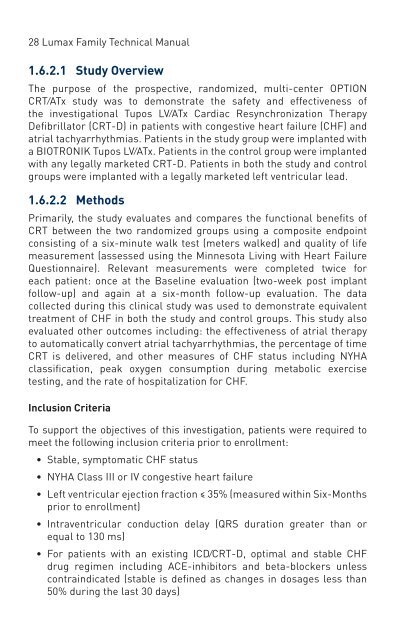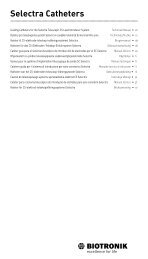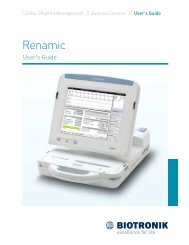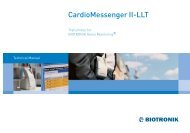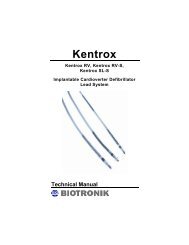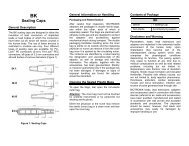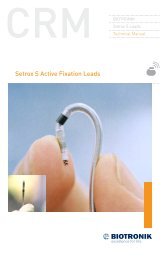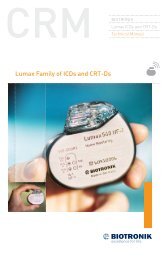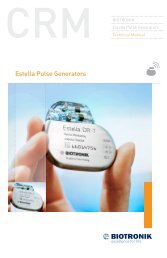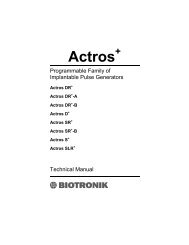Lumax Family of ICDs and CRTâDs - BIOTRONIK USA - News
Lumax Family of ICDs and CRTâDs - BIOTRONIK USA - News
Lumax Family of ICDs and CRTâDs - BIOTRONIK USA - News
You also want an ePaper? Increase the reach of your titles
YUMPU automatically turns print PDFs into web optimized ePapers that Google loves.
28 <strong>Lumax</strong> <strong>Family</strong> Technical Manual<br />
1.6.2.1 Study Overview<br />
The purpose <strong>of</strong> the prospective, r<strong>and</strong>omized, multi‐center OPTION<br />
CRT⁄ATx study was to demonstrate the safety <strong>and</strong> effectiveness <strong>of</strong><br />
the investigational Tupos LV⁄ATx Cardiac Resynchronization Therapy<br />
Defibrillator (CRT‐D) in patients with congestive heart failure (CHF) <strong>and</strong><br />
atrial tachyarrhythmias. Patients in the study group were implanted with<br />
a <strong>BIOTRONIK</strong> Tupos LV⁄ATx. Patients in the control group were implanted<br />
with any legally marketed CRT‐D. Patients in both the study <strong>and</strong> control<br />
groups were implanted with a legally marketed left ventricular lead.<br />
1.6.2.2 Methods<br />
Primarily, the study evaluates <strong>and</strong> compares the functional benefits <strong>of</strong><br />
CRT between the two r<strong>and</strong>omized groups using a composite endpoint<br />
consisting <strong>of</strong> a six‐minute walk test (meters walked) <strong>and</strong> quality <strong>of</strong> life<br />
measurement (assessed using the Minnesota Living with Heart Failure<br />
Questionnaire). Relevant measurements were completed twice for<br />
each patient: once at the Baseline evaluation (two‐week post implant<br />
follow‐up) <strong>and</strong> again at a six‐month follow‐up evaluation. The data<br />
collected during this clinical study was used to demonstrate equivalent<br />
treatment <strong>of</strong> CHF in both the study <strong>and</strong> control groups. This study also<br />
evaluated other outcomes including: the effectiveness <strong>of</strong> atrial therapy<br />
to automatically convert atrial tachyarrhythmias, the percentage <strong>of</strong> time<br />
CRT is delivered, <strong>and</strong> other measures <strong>of</strong> CHF status including NYHA<br />
classification, peak oxygen consumption during metabolic exercise<br />
testing, <strong>and</strong> the rate <strong>of</strong> hospitalization for CHF.<br />
Inclusion Criteria<br />
To support the objectives <strong>of</strong> this investigation, patients were required to<br />
meet the following inclusion criteria prior to enrollment:<br />
• Stable, symptomatic CHF status<br />
• NYHA Class III or IV congestive heart failure<br />
• Left ventricular ejection fraction ≤ 35% (measured within Six‐Months<br />
prior to enrollment)<br />
• Intraventricular conduction delay (QRS duration greater than or<br />
equal to 130 ms)<br />
• For patients with an existing ICD⁄CRT‐D, optimal <strong>and</strong> stable CHF<br />
drug regimen including ACE‐inhibitors <strong>and</strong> beta‐blockers unless<br />
contraindicated (stable is defined as changes in dosages less than<br />
50% during the last 30 days)


